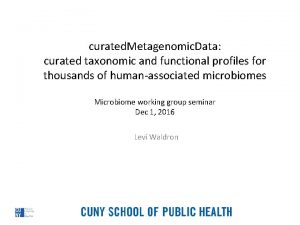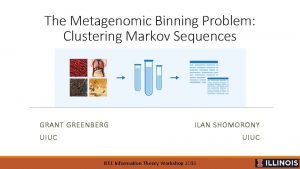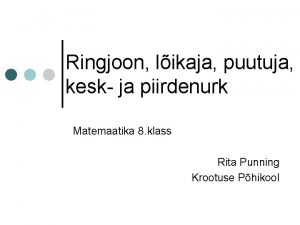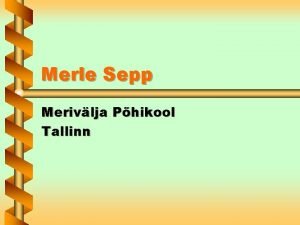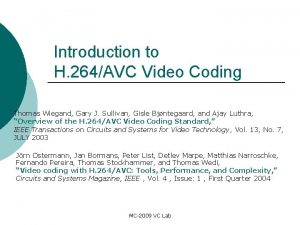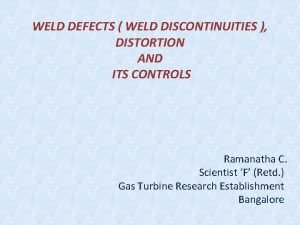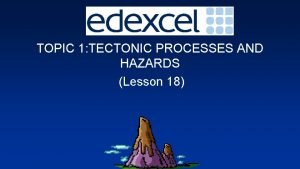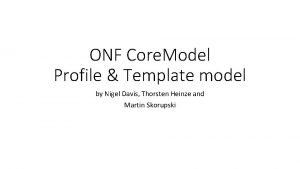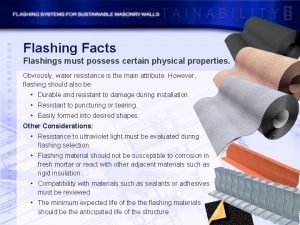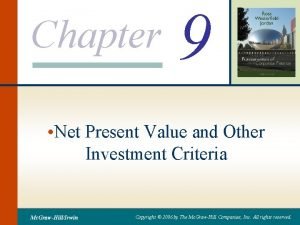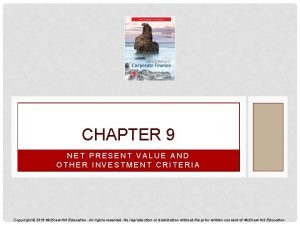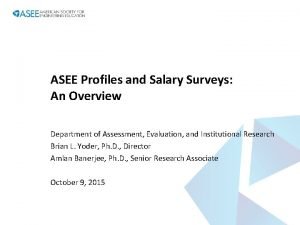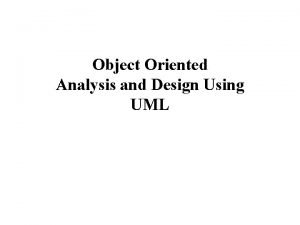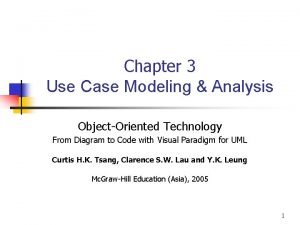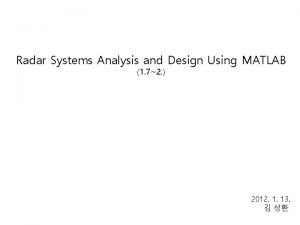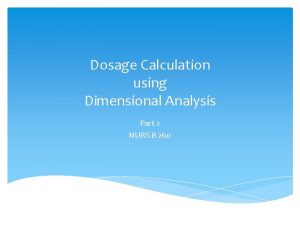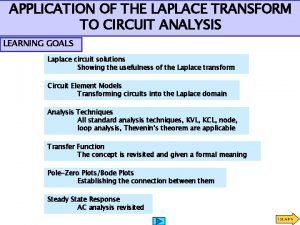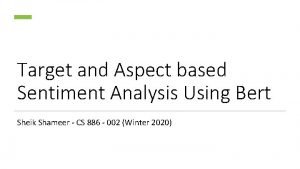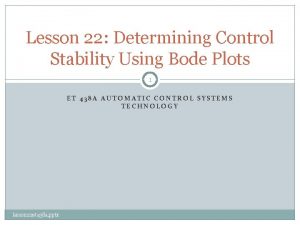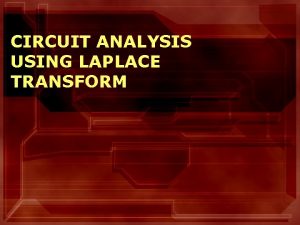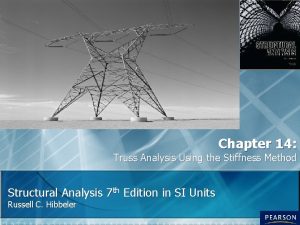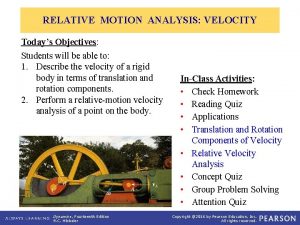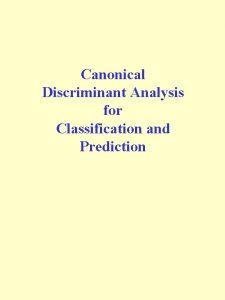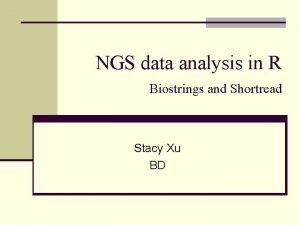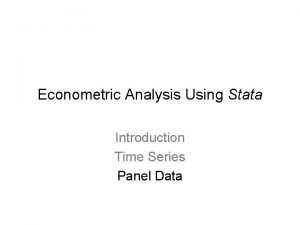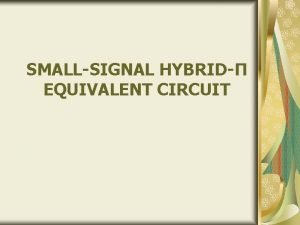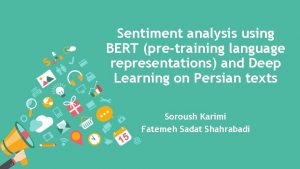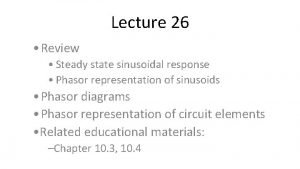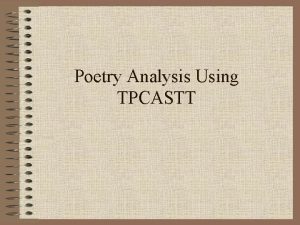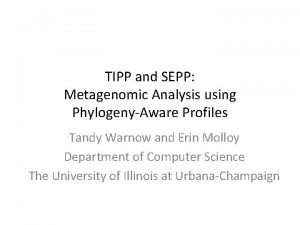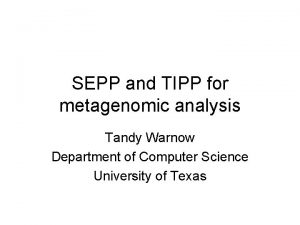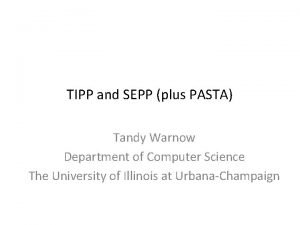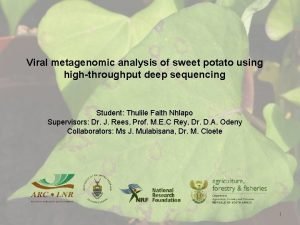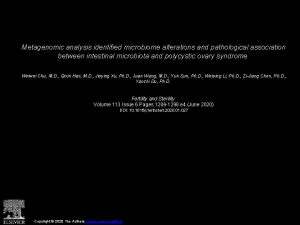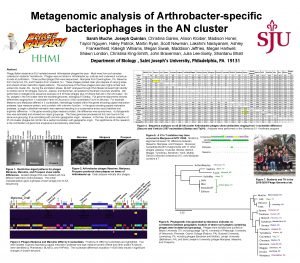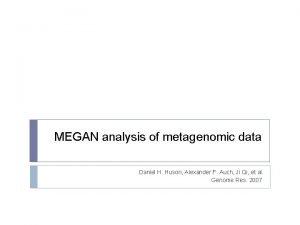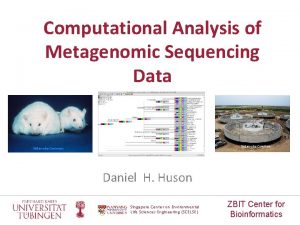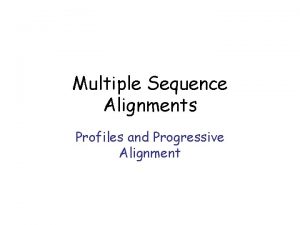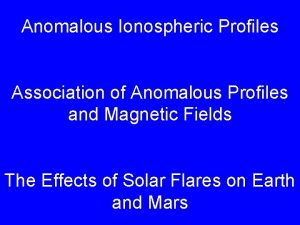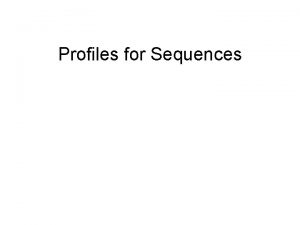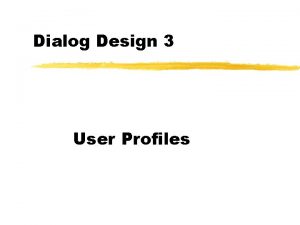TIPP and SEPP Metagenomic Analysis using PhylogenyAware Profiles

































































- Slides: 65

TIPP and SEPP: Metagenomic Analysis using Phylogeny-Aware Profiles Tandy Warnow and Erin Molloy Department of Computer Science The University of Illinois at Urbana-Champaign

Metagenomic taxonomic identification and phylogenetic profiling Metagenomics, Venter et al. , Exploring the Sargasso Sea: Scientists Discover One Million New Genes in Ocean Microbes

Basic Questions 1. What is this fragment? (Classify each fragment as well as possible. ) 2. What is the taxonomic distribution in the dataset? (Note: helpful to use marker genes. ) 3. What are the organisms in this metagenomic sample doing together?

This talk • SEPP (PSB 2012): SATé-enabled Phylogenetic Placement, and Ensembles of HMMs (e. HMMs) • TIPP (Bioinformatics 2014): Applications of the e. HMM technique to metagenomic abundance classification Both available at https: //github. com/smirarab/sepp

Phylogenetic Placement Input: Backbone alignment and tree on full-length sequences, and a set of homologous query sequences (e. g. , reads in a metagenomic sample for the same gene) Output: Placement of query sequences on backbone tree Phylogenetic placement can be used inside a pipeline, after determining the genes for each of the reads in the metagenomic sample.

Marker-based Taxon Identification Fragmentary sequences from some gene ACCG CGAG CGG GGCT TAGA GGGGG TCGAG GGCG GGG • . ACCT Full-length sequences for same gene, and an alignment and a tree AGG. . . GCAT TAGC. . . CCA TAGA. . . CTT AGC. . . ACA ACT. . TAGA. . A

Input S 1 S 2 S 3 S 4 Q 1 = = = -AGGCTATCACCTGACCTCCA-AA TAG-CTATCAC--GACCGC--GCA TAG-CT-------GACCGC--GCT TAC----TCAC--GACCGACAGCT TAAAAC S 1 S 4 S 2 S 3

Align Sequence S 1 S 2 S 3 S 4 Q 1 = = = -AGGCTATCACCTGACCTCCA-AA TAG-CTATCAC--GACCGC--GCA TAG-CT-------GACCGC--GCT TAC----TCAC--GACCGACAGCT -------T-A--AAAC---- S 1 S 4 S 2 S 3

Place Sequence S 1 S 2 S 3 S 4 Q 1 = = = -AGGCTATCACCTGACCTCCA-AA TAG-CTATCAC--GACCGC--GCA TAG-CT-------GACCGC--GCT TAC----TCAC--GACCGACAGCT -------T-A--AAAC---- S 1 S 4 S 2 Q 1 S 3

Phylogenetic Placement in 2011 • Align each query sequence to backbone alignment – HMMER (Finn et al. , NAR 2011) – Pa. Ra (Berger and Stamatakis, Bioinformatics 2011) • Place each query sequence into backbone tree – pplacer (Matsen et al. , BMC Bioinformatics, 2011) – EPA (Berger and Stamatakis, Systematic Biology 2011) Note: pplacer and EPA solve same problem (maximum likelihood placement under standard sequence evolution models)

HMMER vs. Pa. Ra Alignments 0. 0 Increasing rate of evolution

Input S 1 S 2 S 3 S 4 Q 1 = = = -AGGCTATCACCTGACCTCCA-AA TAG-CTATCAC--GACCGC--GCA TAG-CT-------GACCGC--GCT TAC----TCAC--GACCGACAGCT TAAAAC S 1 S 4 S 2 S 3

Align Sequence using HMMER S 1 S 2 S 3 S 4 Q 1 = = = -AGGCTATCACCTGACCTCCA-AA TAG-CTATCAC--GACCGC--GCA TAG-CT-------GACCGC--GCT TAC----TCAC--GACCGACAGCT -------T-A--AAAC---- S 1 S 4 S 2 S 3

Place Sequence using pplacer S 1 S 2 S 3 S 4 Q 1 = = = -AGGCTATCACCTGACCTCCA-AA TAG-CTATCAC--GACCGC--GCA TAG-CT-------GACCGC--GCT TAC----TCAC--GACCGACAGCT -------T-A--AAAC---- S 1 S 4 S 2 Q 1 S 3

What is HMMER+pplacer? • HMMER (Finn et al. , NAR 2011) is used to add the read s into the backbone alignment, thus producing an “extended alignment”. HMMER is based on profile Hidden Markov Models (profile HMMs). • pplacer (Matsen et al. BMC Bioinformatics 2010) is used to add read s into the best location in the tree T. pplacer is based on phylogenetic sequence evolution models (e. g. , GTR), and uses maximum likelihood.


A general topology for a profile HMM From http: //codecereal. blogspot. com/2011/07/protein-profile-with-hmm. html

Profile Hidden Markov Models Profile HMMs are probabilistic generative models to represent multiple sequence alignments. HMMER software suite can • • Build a profile HMM given a multiple sequence alignment A Use the profile HMM to add a sequence s into A, and return the “probability” that the HMM generated s In other words, profile HMMs can be used to compute extended alignments, and score them!

Input S 1 S 2 S 3 S 4 Q 1 = = = -AGGCTATCACCTGACCTCCA-AA TAG-CTATCAC--GACCGC--GCA TAG-CT-------GACCGC--GCT TAC----TCAC--GACCGACAGCT TAAAAC S 1 S 4 S 2 S 3

Align Sequence using HMMER S 1 S 2 S 3 S 4 Q 1 = = = -AGGCTATCACCTGACCTCCA-AA TAG-CTATCAC--GACCGC--GCA TAG-CT-------GACCGC--GCT TAC----TCAC--GACCGACAGCT -------T-A--AAAC---- S 1 S 4 1. Build a profile HMM for the backbone alignment 2. Compute a maximum likelihood path through the profile HMM for Q 1 and use it to compute the extended alignment. 3. Note the maximum likelihood score for the alignment! S 2 S 3

What is pplacer? • pplacer: software developed by Erick Matsen and colleagues. See http: //matsen. fhcrc. org/pplacer/ • Input: read s, alignment A (on S and s), tree on S • Output: – “Best” location to add s in T (under maximum likelihood). – For every edge e in T, the value p(e) for the probability for s being placed on e (these probabilities add up to 1)

Place Sequence using pplacer S 1 S 2 S 3 S 4 Q 1 = = = -AGGCTATCACCTGACCTCCA-AA TAG-CTATCAC--GACCGC--GCA TAG-CT-------GACCGC--GCT TAC----TCAC--GACCGACAGCT -------T-A--AAAC---- S 1 S 4 1. For every edge in T, let Te be the tree created by adding Q 1 to that edge. Compute the maximum likelihood (ML) score of the tree Te for the extended alignment. (Use the ML scores to assign probabilities p(e) to all edges e!) 2. Return Te that has the best ML score. S 2 S 3

Place Sequence using pplacer S 1 S 2 S 3 S 4 Q 1 = = = -AGGCTATCACCTGACCTCCA-AA TAG-CTATCAC--GACCGC--GCA TAG-CT-------GACCGC--GCT TAC----TCAC--GACCGACAGCT -------T-A--AAAC---- S 1 0. 03 0. 4 0. 05 S 4 0. 5 0. 02 1. For every edge in T, let Te be the tree created by adding Q 1 to that edge. Compute the maximum likelihood (ML) score of the tree Te for the extended alignment. (Use the ML scores to assign probabilities p(e) to all edges e!) S 2 S 3

Place Sequence using pplacer S 1 S 2 S 3 S 4 Q 1 = = = -AGGCTATCACCTGACCTCCA-AA TAG-CTATCAC--GACCGC--GCA TAG-CT-------GACCGC--GCT TAC----TCAC--GACCGACAGCT -------T-A--AAAC---- S 1 0. 03 0. 4 0. 05 S 4 0. 5 0. 02 1. For every edge in T, let Te be the tree created by adding Q 1 to that edge. Compute the maximum likelihood (ML) score of the tree Te for the extended alignment. (Use the ML scores to assign probabilities p(e) to all edges e!) 2. Return Te that has the best ML score. S 2 S 3

Place Sequence using pplacer S 1 S 2 S 3 S 4 Q 1 = = = -AGGCTATCACCTGACCTCCA-AA TAG-CTATCAC--GACCGC--GCA TAG-CT-------GACCGC--GCT TAC----TCAC--GACCGACAGCT -------T-A--AAAC---- S 1 S 4 S 2 Q 1 1. For every edge in T, let Te be the tree created by adding Q 1 to that edge. Compute the maximum likelihood (ML) score of the tree Te for the extended alignment. (Use the ML scores to assign probabilities p(e) to all edges e!) 2. Return Te that has the best ML score. S 3

HMMER vs. Pa. Ra Alignments 0. 0 Increasing rate of evolution

One Hidden Markov Model for the entire alignment? HMM 1

One HMM works beautifully for small-diameter trees

One HMM works poorly for large-diameter trees

One Hidden Markov Model for the entire alignment?

Or 2 HMMs? HMM 1 HMM 2

Or 4 HMMs? HMM 1 HMM 3 HMM 2 HMM 4

SEPP Design To insert query sequence Q 1 into backbone tree T § § Represent the backbone MSA with a collection of profile HMMs, based on maximum ”alignment subset size” Score Q 1 against every profile HMM in the collection The best scoring HMM is used to compute the extended alignment Use pplacer to add Q 1 into tree T (restricted to ”subtree” based on maximum ”placement subset size”)

One Hidden Markov Model for the entire alignment?

Or 2 HMMs? HMM 1 HMM 2

Or 4 HMMs? HMM 1 HMM 3 HMM 2 HMM 4

SEPP Parameter Exploration § § Alignment subset size and placement subset size impact the accuracy, running time, and memory of SEPP: § Small alignment subset sizes best § Large placement subset size best 10% rule (both subset sizes 10% of backbone) had best overall performance

SEPP (10%-rule) on simulated data 0. 0 Increasing rate of evolution

SEPP and e. HMMs An ensemble of HMMs provides a better model of a multiple sequence alignment than a single HMM, and is better able to • detect homology between full length sequences and fragmentary sequences • add fragmentary sequences into an existing alignment especially when there are many indels and/or substitutions.

Metagenomic Taxon Identification Objective: classify short reads in a metagenomic sample

Abundance Profiling Objective: Distribution of the species (or genera, or families, etc. ) within the sample. For example: The distribution of the sample at the species-level is: 50% species A 20% species B 15% species C 14% species D 1% species E

TIPP (https: //github. com/smirarab/sepp) TIPP (Nguyen, Mirarb, Liu, Pop, and Warnow, Bioinformatics 2014), marker-based method that only characterizes those reads that map to the Metaphyler’s marker genes TIPP pipeline 1. Uses BLAST to assign reads to marker genes 2. Computes UPP/PASTA reference alignments 3. Uses reference taxonomies, refined to binary trees using reference alignment 4. Modifies SEPP by considering statistical uncertainty in the extended alignment and placement within the tree. – Can consider more than one extended alignment – Can consider more than optimal placement in the tree for each extended alignment – Assign taxonomic label based on MRCA of all selected placements for all selected extended alignment

TIPP (https: //github. com/smirarab/sepp) TIPP (Nguyen, Mirarb, Liu, Pop, and Warnow, Bioinformatics 2014), marker-based method that only characterizes those reads that map to the Metaphyler’s marker genes TIPP pipeline 1. Uses BLAST to assign reads to marker genes 2. Computes UPP/PASTA reference alignments 3. Uses reference taxonomies, refined to binary trees using reference alignment 4. Modifies SEPP by considering statistical uncertainty in the extended alignment and placement within the tree. – Can consider more than one extended alignment – Can consider more than optimal placement in the tree for each extended alignment – Assign taxonomic label based on MRCA of all selected placements for all selected extended alignment

TIPP (https: //github. com/smirarab/sepp) TIPP (Nguyen, Mirarb, Liu, Pop, and Warnow, Bioinformatics 2014), marker-based method that only characterizes those reads that map to the Metaphyler’s marker genes TIPP pipeline 1. Uses BLAST to assign reads to marker genes 2. Computes UPP/PASTA reference alignments 3. Uses reference taxonomies, refined to binary trees using reference alignment 4. Modifies SEPP by considering statistical uncertainty in the extended alignment and placement within the tree. – Can consider more than one extended alignment – Can consider more than optimal placement in the tree for each extended alignment – Assign taxonomic label based on MRCA of all selected placements for all selected extended alignment

TIPP (https: //github. com/smirarab/sepp) TIPP (Nguyen, Mirarb, Liu, Pop, and Warnow, Bioinformatics 2014), marker-based method that only characterizes those reads that map to the Metaphyler’s marker genes TIPP pipeline 1. Uses BLAST to assign reads to marker genes 2. Computes UPP/PASTA reference alignments 3. Uses reference taxonomies, refined to binary trees using reference alignment 4. Modifies SEPP by considering statistical uncertainty in the extended alignment and placement within the tree. – Can consider more than one extended alignment – Can consider more than one placement in the tree for each extended alignment – Assign taxonomic label based on MRCA of all selected placements for all selected extended alignments

TIPP Design (Step 4) • Input: marker gene reference alignment (computed using PASTA, RECOMB 2014), species taxonomy, alignment support threshold (default 95%) and placement support threshold (default 95%) • For each marker gene, and its associated bin of reads: – Builds e. HMM to represent the MSA – For each read: • Use the e. HMM to produce a set of extended MSAs that include the read, sufficient to reach the specified alignment support threshold. • For each extended MSA, use pplacer to place the read into the taxonomy optimizing maximum likelihood and identify all the clades in the tree with sufficiently high likelihood to meet the specified placement support threshold. (Note – this will be a single clade if the support threshold is at strictly greater than 50%. ) • Taxonomically characterize each read at the MRCA of these clades.

TIPP Design (Step 4) • Input: marker gene reference alignment (computed using PASTA, RECOMB 2014), species taxonomy, alignment support threshold (default 95%) and placement support threshold (default 95%) • For each marker gene, and its associated bin of reads: – Builds e. HMM to represent the MSA – For each read: • Use the e. HMM to produce a set of extended MSAs that include the read, sufficient to reach the specified alignment support threshold. • For each extended MSA, use pplacer to place the read into the taxonomy optimizing maximum likelihood and identify all the clades in the tree with sufficiently high likelihood to meet the specified placement support threshold. (Note – this will be a single clade if the support threshold is at strictly greater than 50%. ) • Taxonomically characterize each read at the MRCA of these clades.

TIPP Design (Step 4) • Input: marker gene reference alignment (computed using PASTA, RECOMB 2014), species taxonomy, alignment support threshold (default 95%) and placement support threshold (default 95%) • For each marker gene, and its associated bin of reads: – Builds e. HMM to represent the MSA – For each read: • Use the e. HMM to produce a set of extended MSAs that include the read, sufficient to reach the specified alignment support threshold. • For each extended MSA, use pplacer to place the read into the taxonomy optimizing maximum likelihood and identify all the clades in the tree with sufficiently high likelihood to meet the specified placement support threshold. (Note – this will be a single clade if the support threshold is at strictly greater than 50%. ) • Taxonomically characterize each read at the MRCA of these clades.

TIPP Design (Step 4) • Input: marker gene reference alignment (computed using PASTA, RECOMB 2014), species taxonomy, alignment support threshold (default 95%) and placement support threshold (default 95%) • For each marker gene, and its associated bin of reads: – Builds e. HMM to represent the MSA – For each read: • Use the e. HMM to produce a set of extended MSAs that include the read, sufficient to reach the specified alignment support threshold. • For each extended MSA, use pplacer to place the read into the taxonomy optimizing maximum likelihood and identify all the clades in the tree with sufficiently high likelihood to meet the specified placement support threshold. (Note – this will be a single clade if the support threshold is at strictly greater than 50%. ) • Taxonomically characterize each read at the MRCA of these clades.

TIPP Design (Step 4) • Input: marker gene reference alignment (computed using PASTA, RECOMB 2014), species taxonomy, alignment support threshold (default 95%) and placement support threshold (default 95%) • For each marker gene, and its associated bin of reads: – Builds e. HMM to represent the MSA – For each read: • Use the e. HMM to produce a set of extended MSAs that include the read, sufficient to reach the specified alignment support threshold. • For each extended MSA, use pplacer to place the read into the taxonomy optimizing maximum likelihood and identify all the clades in the tree with sufficiently high likelihood to meet the specified placement support threshold. (Note – this will be a single clade if the support threshold is at strictly greater than 50%. ) • Taxonomically characterize each read at the MRCA of these clades.

TIPP Design (Step 4) • Input: marker gene reference alignment (computed using PASTA, RECOMB 2014), species taxonomy, alignment support threshold (default 95%) and placement support threshold (default 95%) • For each marker gene, and its associated bin of reads: – Builds e. HMM to represent the MSA – For each read: • Use the e. HMM to produce a set of extended MSAs that include the read, sufficient to reach the specified alignment support threshold. • For each extended MSA, use pplacer to place the read into the taxonomy optimizing maximum likelihood and identify all the clades in the tree with sufficiently high likelihood to meet the specified placement support threshold. (Note – this will be a single clade if the support threshold is at strictly greater than 50%. ) • Taxonomically characterize each read at the MRCA of these clades.

TIPP Design (Step 4) • Input: marker gene reference alignment (computed using PASTA, RECOMB 2014), species taxonomy, alignment support threshold (default 95%) and placement support threshold (default 95%) • For each marker gene, and its associated bin of reads: – Builds e. HMM to represent the MSA – For each read: • Use the e. HMM to produce a set of extended MSAs that include the read, sufficient to reach the specified alignment support threshold. • For each extended MSA, use pplacer to place the read into the taxonomy optimizing maximum likelihood and identify all the clades in the tree with sufficiently high likelihood to meet the specified placement support threshold. (Note – this will be a single clade if the support threshold is at strictly greater than 50%. ) • Taxonomically characterize each read at the MRCA of these clades.

Abundance Profiling Objective: Distribution of the species (or genera, or families, etc. ) within the sample. We compared TIPP to Phymm. BL (Brady & Salzberg, Nature Methods 2009) NBC (Rosen, Reichenberger, and Rosenfeld, Bioinformatics 2011) Meta. Phyler (Liu et al. , BMC Genomics 2011), from the Pop lab at the University of Maryland Meta. Phl. An (Segata et al. , Nature Methods 2012), from the Huttenhower Lab at Harvard m. OTU (Bork et al. , Nature Methods 2013) Meta. Phyler, Meta. Phl. An, and m. OTU are marker-based techniques (but use different marker genes). Marker gene are single-copy, universal, and resistant to horizontal transmission.

High indel datasets containing known genomes Note: NBC, Meta. Phl. An, and Meta. Phyler cannot classify any sequences from at least one of the high indel long sequence datasets, and m. OTU terminates with an error message on all the high indel datasets.

“Novel” genome datasets Note: m. OTU terminates with an error message on the long fragment datasets and high indel datasets.

TIPP vs. other abundance profilers • TIPP is highly accurate, even in the presence of high indel rates and novel genomes, and for both short and long reads. • All other methods have some vulnerability (e. g. , m. OTU is only accurate for short reads and is impacted by high indel rates). • Improved accuracy is due to the use of e. HMMs; single HMMs do not provide the same advantages, especially in the presence of high indel rates.

Still to do • Evaluate TIPP in comparison to newer methods (e. g. , Kraken) • Evaluating TIPP with respect to taxonomic identification and identification of novel taxa. • Update TIPP’s design!

HIPPI • HIerarchical Profile HMMs for Protein family Identification • Nguyen, Nute, Mirarab, and Warnow, RECOMB-CG and BMC-Genomics 2016 • Uses an ensemble of HMMs to classify protein sequences • Tested on HMMER

Protein Family Assignment • Input: new AA sequence (might be fragmentary) and database of protein families (e. g. , PFAM) • Output: assignment (if justified) of the sequence to an existing family in the database

TIPPI: Replacing BLAST by HIPPI within TIPP

Our Publications using e. HMMs • S. Mirarab, N. Nguyen, and T. Warnow. "SEPP: SATé-Enabled Phylogenetic Placement. " Proceedings of the 2012 Pacific Symposium on Biocomputing (PSB 2012) 17: 247 -258. • N. Nguyen, S. Mirarab, B. Liu, M. Pop, and T. Warnow "TIPP: Taxonomic Identification and Phylogenetic Profiling. " Bioinformatics (2014) 30(24): 3548 -3555. • N. Nguyen, S. Mirarab, K. Kumar, and T. Warnow, "Ultra-large alignments using phylogeny aware profiles". Proceedings RECOMB 2015 and Genome Biology (2015) 16: 124 • N. Nguyen, M. Nute, S. Mirarab, and T. Warnow, HIPPI: Highly accurate protein family classification with ensembles of HMMs. BMC Genomics (2016): 17 (Suppl 10): 765 All codes are available in open source form at https: //github. com/smirarab/sepp

Summary • Using an ensemble of HMMs tends to improve accuracy, for a cost of running time. Applications so far to taxonomic placement (SEPP), multiple sequence alignment (UPP), protein family classification (HIPPI). Improvements are mostly noticeable for large diverse datasets. • Phylogenetically-based construction of the ensemble helps accuracy (note: the decompositions we produce are not clade-based), but the design and use of these ensembles is still in its infancy. (Many relatively similar approaches have been used by others, including Flower. Power by Sjolander) • The basic idea can be used with any kind of probabilistic model, doesn’t have to be restricted to profile HMMs. • Basic question: why does it help?

Using SEPP algorithmic parameters: – Alignment subset size (how many sequences for each profile HMM in the ensemble? ) – Placement subset size (how much of the tree to search for optimal placement? ) Default settings are acceptable, but you can improve accuracy by increasing placement subset size (and maybe decreasing alignment subset size), for a running time cost.

Using TIPP algorithmic parameters (other than SEPP parameters) – Reference markers – Alignment threshold (default 95%) – Placement threshold (default 95%) The alignment threshold and placement threshold were optimized for abundance profiling, not for Taxon ID.

Acknowledgments Ph. D students: Nam Nguyen (now postdoc at UCSD) and Siavash Mirarab (now faculty at UCSD), and Bo Liu (now at Square) Mihai Pop, University of Maryland NSF grants to TW: DBI: 1062335, DEB 0733029, III: AF: 1513629 NIH grant to MP: R 01 -A 1 -100947 Also: Guggenheim Foundation Fellowship (to TW), Microsoft Research New England (to TW), David Bruton Jr. Centennial Professorship (to TW), Grainger Foundation (to TW), HHMI Predoctoral Fellowship (to SM) TACC, UTCS, and UIUC computational resources
 Curatedmetagenomicdata
Curatedmetagenomicdata Metagenomic binning
Metagenomic binning Ringi ümbermõõt
Ringi ümbermõõt Dbt chain analysis worksheet
Dbt chain analysis worksheet Tipp ex sonate
Tipp ex sonate Willing hands dbt
Willing hands dbt Tipp24 online games
Tipp24 online games Number translation using voice translation profiles
Number translation using voice translation profiles Merle sepp
Merle sepp Anneli sepp
Anneli sepp Ene parv
Ene parv Anneli sepp
Anneli sepp Merlin sepp
Merlin sepp Marju sepp
Marju sepp Codes sepp
Codes sepp Schulsystem finnland stundenplan
Schulsystem finnland stundenplan Neuroimaging
Neuroimaging Betts neihart profiles of the gifted and talented
Betts neihart profiles of the gifted and talented H.264 profiles and levels
H.264 profiles and levels Excessive concavity welding
Excessive concavity welding Hazard profile examples
Hazard profile examples Who is jean louise
Who is jean louise Modern project profiles in spm
Modern project profiles in spm Alma publishing profiles
Alma publishing profiles Onf profile
Onf profile Netsh wlan show profiles
Netsh wlan show profiles Specific flashing profiles
Specific flashing profiles Npv profiles
Npv profiles Npv profiles
Npv profiles Modified irr
Modified irr Chapter 9 net present value and other investment criteria
Chapter 9 net present value and other investment criteria Npv profiles
Npv profiles Payback chapter 8
Payback chapter 8 Payback chapter 10
Payback chapter 10 Asee profiles
Asee profiles Ghost profiles
Ghost profiles Corporate traveler profiles
Corporate traveler profiles Mining company profile doc
Mining company profile doc Psychographic profiles
Psychographic profiles To kill a mockingbird jean louise
To kill a mockingbird jean louise Aitsl leadership profiles
Aitsl leadership profiles Cultural intelligence profiles
Cultural intelligence profiles System collections generic
System collections generic Accumulator ac
Accumulator ac Radar systems analysis and design using matlab
Radar systems analysis and design using matlab Object-oriented systems analysis and design using uml
Object-oriented systems analysis and design using uml Object oriented analysis and design using uml
Object oriented analysis and design using uml Use case description
Use case description Pyspark sentiment analysis
Pyspark sentiment analysis Radar system analysis and design using matlab
Radar system analysis and design using matlab How to calculate drip rate
How to calculate drip rate S domain capacitor
S domain capacitor Aspect based sentiment analysis using bert
Aspect based sentiment analysis using bert Stability analysis using bode plot
Stability analysis using bode plot Find v
Find v S-domain circuit analysis examples
S-domain circuit analysis examples Truss analysis using stiffness method
Truss analysis using stiffness method Relative motion analysis velocity
Relative motion analysis velocity Control volume energy balance
Control volume energy balance Standardized canonical discriminant function coefficients
Standardized canonical discriminant function coefficients Ngs data analysis in r
Ngs data analysis in r Time series analysis using stata
Time series analysis using stata Small signal analysis of bjt using hybrid-pi model
Small signal analysis of bjt using hybrid-pi model Nbsvm
Nbsvm Steady state sinusoidal analysis using phasors
Steady state sinusoidal analysis using phasors Paraphrase tpcastt
Paraphrase tpcastt
